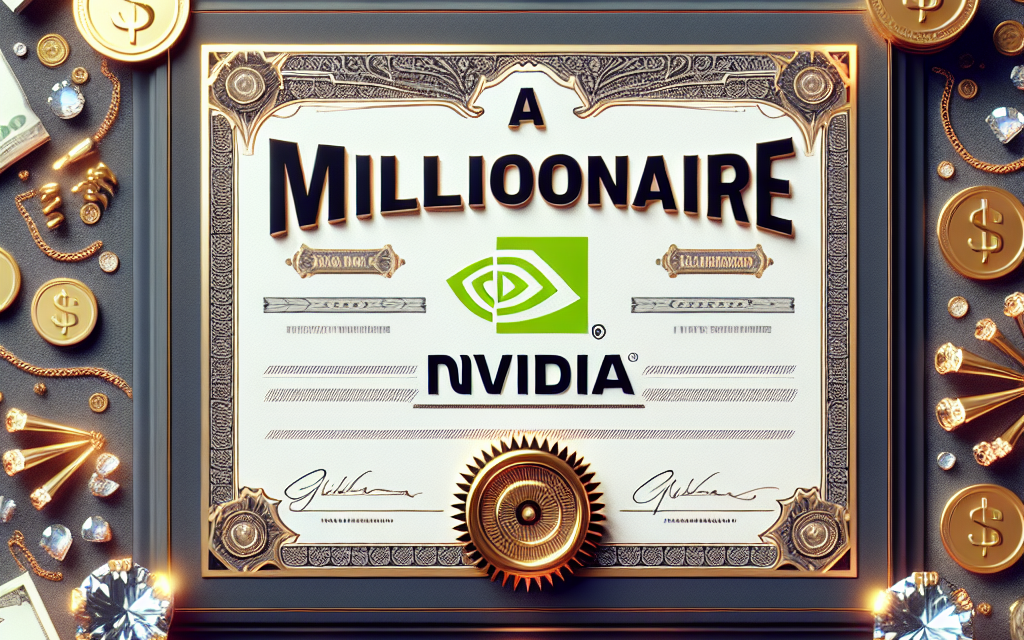“Unlock Future Wealth: Nvidia’s Potential to Power Your Millionaire Dreams!”
Introduction
Nvidia Corporation, a leading player in the semiconductor industry, has long been a favorite among investors due to its innovative technologies and strong market presence. Known for its cutting-edge graphics processing units (GPUs) and advancements in artificial intelligence (AI), Nvidia has experienced significant growth over the years, capturing the attention of both retail and institutional investors. As the company continues to expand its influence across various sectors, including gaming, data centers, and autonomous vehicles, the question arises: Is Nvidia still a stock that can make you a millionaire? This inquiry delves into the company’s current market position, growth prospects, and potential challenges to assess whether Nvidia remains a lucrative investment opportunity capable of delivering substantial returns.
Evaluating Nvidia’s Growth Potential in the Current Market
Nvidia Corporation, a leading player in the semiconductor industry, has long been a favorite among investors seeking substantial returns. Known for its cutting-edge graphics processing units (GPUs) and its pivotal role in the development of artificial intelligence (AI) technologies, Nvidia has consistently demonstrated robust growth. However, as the market landscape evolves, potential investors are left wondering whether Nvidia still holds the potential to transform a modest investment into a million-dollar fortune.
To evaluate Nvidia’s growth potential, it is essential to consider the company’s current market position and the broader industry trends. Nvidia’s dominance in the GPU market remains unchallenged, with its products being integral to gaming, professional visualization, data centers, and automotive sectors. The company’s GPUs are not only crucial for high-performance gaming but also for AI and machine learning applications, which are experiencing exponential growth. This diversification across multiple high-growth industries provides Nvidia with a solid foundation for continued expansion.
Moreover, Nvidia’s strategic acquisitions and partnerships further bolster its growth prospects. The acquisition of Mellanox Technologies in 2020, for instance, enhanced Nvidia’s capabilities in high-performance computing and data center solutions. Such strategic moves enable Nvidia to expand its product offerings and tap into new markets, thereby driving revenue growth. Additionally, Nvidia’s collaboration with leading tech companies to develop AI and machine learning solutions positions it at the forefront of technological innovation.
However, while Nvidia’s growth potential appears promising, it is crucial to acknowledge the challenges and risks that could impact its trajectory. The semiconductor industry is highly competitive, with companies like AMD and Intel constantly vying for market share. Any technological advancements or pricing strategies by competitors could potentially erode Nvidia’s market dominance. Furthermore, the cyclical nature of the semiconductor industry means that Nvidia is susceptible to fluctuations in demand, which could affect its financial performance.
Another factor to consider is the regulatory environment. Nvidia’s attempted acquisition of ARM Holdings faced significant regulatory hurdles, highlighting the complexities of navigating international trade and antitrust laws. Such challenges could impede Nvidia’s ability to execute future strategic acquisitions, which are vital for sustaining its growth momentum.
Despite these challenges, Nvidia’s financial performance remains robust. The company has consistently reported strong revenue growth and profitability, driven by its innovative product offerings and strategic market positioning. Nvidia’s commitment to research and development ensures that it remains at the cutting edge of technology, continually introducing new products that meet the evolving needs of its customers.
In conclusion, while Nvidia faces certain challenges, its strong market position, strategic initiatives, and financial performance suggest that it still holds significant growth potential. For investors, the key to realizing substantial returns lies in understanding the company’s long-term vision and its ability to adapt to changing market dynamics. While no investment is without risk, Nvidia’s track record of innovation and market leadership makes it a compelling option for those seeking to capitalize on the growth of the semiconductor and AI industries. As such, Nvidia remains a stock with the potential to deliver substantial returns, though investors should carefully consider the associated risks and market conditions before making investment decisions.
Analyzing Nvidia’s Financial Performance and Future Projections
Nvidia Corporation, a leading player in the semiconductor industry, has long been a favorite among investors seeking substantial returns. Known for its cutting-edge graphics processing units (GPUs) and its pivotal role in the burgeoning fields of artificial intelligence (AI) and machine learning, Nvidia has consistently demonstrated robust financial performance. However, the question remains: is Nvidia still a stock that can make you a millionaire? To answer this, one must delve into its recent financial performance and future projections.
In recent years, Nvidia has experienced remarkable growth, driven by its dominance in the GPU market and its strategic expansion into data centers and AI technologies. The company’s financial statements reveal a consistent upward trajectory in revenue and profitability. For instance, Nvidia’s revenue for the fiscal year 2023 reached unprecedented heights, reflecting a significant increase from previous years. This growth can be attributed to the surging demand for GPUs, not only for gaming but also for professional visualization, data centers, and automotive applications. Moreover, Nvidia’s gross margins have remained strong, underscoring its ability to maintain pricing power and operational efficiency.
Transitioning to future projections, Nvidia’s prospects appear promising, bolstered by its strategic initiatives and market trends. The company’s foray into AI and machine learning is particularly noteworthy. As industries increasingly adopt AI-driven solutions, Nvidia’s GPUs are becoming indispensable for training and deploying AI models. This trend is expected to continue, providing Nvidia with a substantial growth avenue. Additionally, the company’s acquisition of Arm Holdings, a leader in semiconductor intellectual property, is poised to enhance its capabilities and expand its reach into new markets. This acquisition, pending regulatory approval, could potentially reshape the semiconductor landscape and further solidify Nvidia’s position as an industry leader.
Furthermore, Nvidia’s commitment to innovation is evident in its substantial investment in research and development. By consistently pushing the boundaries of technology, Nvidia ensures that it remains at the forefront of the industry. This dedication to innovation not only strengthens its competitive edge but also opens up new revenue streams. For instance, Nvidia’s advancements in autonomous vehicle technology and its partnerships with major automotive manufacturers highlight its potential to capitalize on the growing demand for smart transportation solutions.
However, it is essential to consider potential challenges that could impact Nvidia’s trajectory. The semiconductor industry is highly competitive, with rapid technological advancements and evolving consumer preferences. Nvidia faces competition from established players like AMD and Intel, as well as emerging companies that could disrupt the market. Additionally, geopolitical tensions and supply chain disruptions pose risks that could affect Nvidia’s operations and profitability.
In conclusion, while Nvidia’s past performance and future projections suggest that it remains a strong contender for investors seeking substantial returns, it is crucial to approach any investment with a comprehensive understanding of the associated risks. Nvidia’s strategic positioning in high-growth areas such as AI, data centers, and autonomous vehicles, coupled with its commitment to innovation, provides a solid foundation for continued success. However, investors should remain vigilant, considering both the opportunities and challenges that lie ahead. Ultimately, whether Nvidia can still make you a millionaire depends on a myriad of factors, including market conditions, competitive dynamics, and the company’s ability to execute its strategic vision effectively.
The Impact of AI and Machine Learning on Nvidia’s Stock Value
Nvidia Corporation, a leading player in the semiconductor industry, has long been a favorite among investors, particularly those with an eye on technological innovation. The company’s stock has experienced significant growth over the years, driven by its pioneering advancements in graphics processing units (GPUs) and its strategic positioning in the burgeoning fields of artificial intelligence (AI) and machine learning. As these technologies continue to evolve and permeate various sectors, the impact on Nvidia’s stock value remains a topic of keen interest for investors seeking substantial returns.
The rise of AI and machine learning has been nothing short of transformative, reshaping industries from healthcare to finance, and Nvidia has been at the forefront of this revolution. The company’s GPUs are renowned for their ability to handle complex computations at high speeds, making them indispensable in AI applications. This technological edge has allowed Nvidia to capture a significant share of the AI hardware market, positioning it as a critical enabler of AI-driven innovations. Consequently, the demand for Nvidia’s products has surged, contributing to robust revenue growth and, by extension, an increase in its stock value.
Moreover, Nvidia’s strategic investments and partnerships have further solidified its standing in the AI and machine learning domains. The acquisition of Mellanox Technologies, for instance, expanded Nvidia’s capabilities in high-performance computing and data center solutions, areas that are integral to AI infrastructure. Such strategic moves have not only diversified Nvidia’s product offerings but also enhanced its competitive advantage, thereby bolstering investor confidence and driving stock appreciation.
In addition to its hardware prowess, Nvidia has made significant strides in software development, particularly with its CUDA platform, which has become a standard in AI and machine learning research. This dual focus on hardware and software has enabled Nvidia to create a comprehensive ecosystem that supports the development and deployment of AI applications. As a result, the company has been able to maintain a strong growth trajectory, which is reflected in its stock performance.
However, while the prospects for Nvidia appear promising, potential investors must also consider the challenges that could impact its stock value. The semiconductor industry is highly competitive, with companies like AMD and Intel constantly vying for market share. Additionally, geopolitical tensions and supply chain disruptions pose risks that could affect Nvidia’s operations and, consequently, its financial performance. These factors underscore the importance of a cautious and informed investment approach.
Furthermore, the rapid pace of technological change means that Nvidia must continuously innovate to maintain its leadership position. The company’s ability to anticipate and adapt to emerging trends will be crucial in sustaining its growth momentum. Investors should therefore monitor Nvidia’s research and development efforts, as well as its strategic initiatives, to gauge its long-term potential.
In conclusion, the impact of AI and machine learning on Nvidia’s stock value is undeniably significant, offering substantial opportunities for wealth creation. While the company’s strong market position and innovative capabilities make it an attractive investment, potential investors should remain vigilant of the inherent risks and challenges. By carefully evaluating Nvidia’s strategic direction and market dynamics, investors can make informed decisions about whether this tech giant still holds the potential to make them millionaires.
Nvidia’s Competitive Edge in the Semiconductor Industry

Nvidia Corporation has long been a formidable player in the semiconductor industry, renowned for its cutting-edge graphics processing units (GPUs) and innovative technologies. As the demand for high-performance computing continues to surge, Nvidia’s competitive edge remains a focal point for investors seeking substantial returns. To understand whether Nvidia is still a stock that can make you a millionaire, it is essential to examine the factors that contribute to its sustained dominance in the semiconductor sector.
Firstly, Nvidia’s commitment to research and development (R&D) is a cornerstone of its competitive advantage. The company consistently allocates a significant portion of its revenue to R&D, ensuring that it remains at the forefront of technological advancements. This dedication has enabled Nvidia to pioneer innovations such as real-time ray tracing and AI-driven graphics, which have set new standards in the industry. By continually pushing the boundaries of what is possible, Nvidia not only maintains its leadership position but also creates new markets for its products.
Moreover, Nvidia’s strategic diversification into data centers, artificial intelligence (AI), and autonomous vehicles has further solidified its competitive edge. The company’s GPUs are not only essential for gaming but also play a critical role in powering AI applications and data center operations. As industries increasingly rely on AI and machine learning, Nvidia’s products have become indispensable, driving robust demand and revenue growth. Additionally, the company’s foray into autonomous vehicle technology positions it well to capitalize on the burgeoning self-driving car market, offering another avenue for substantial growth.
In addition to its technological prowess, Nvidia’s strong partnerships and collaborations enhance its competitive position. The company has forged alliances with major tech firms, including collaborations with cloud service providers like Amazon Web Services and Google Cloud. These partnerships enable Nvidia to integrate its GPUs into a wide array of services, expanding its reach and influence across various sectors. Such collaborations not only bolster Nvidia’s market presence but also provide a steady stream of revenue, contributing to its financial stability.
Furthermore, Nvidia’s acquisition strategy has played a pivotal role in strengthening its competitive edge. The company’s acquisition of Mellanox Technologies, a leader in high-performance computing and networking solutions, exemplifies its strategic approach to expanding its capabilities and market share. By integrating Mellanox’s technology, Nvidia has enhanced its data center offerings, making them more comprehensive and appealing to enterprise customers. This acquisition strategy allows Nvidia to stay ahead of the competition by acquiring complementary technologies and expertise.
However, it is important to acknowledge the challenges that Nvidia faces in maintaining its competitive edge. The semiconductor industry is highly competitive, with rivals such as AMD and Intel constantly vying for market share. Additionally, geopolitical tensions and supply chain disruptions pose potential risks to Nvidia’s operations. Despite these challenges, Nvidia’s robust financial performance, characterized by strong revenue growth and profitability, provides a buffer against market volatility.
In conclusion, Nvidia’s competitive edge in the semiconductor industry is underpinned by its relentless focus on innovation, strategic diversification, strong partnerships, and astute acquisition strategy. While challenges exist, the company’s ability to adapt and thrive in a rapidly evolving landscape positions it as a compelling investment opportunity. For investors seeking to determine whether Nvidia is still a stock that can make them a millionaire, the company’s sustained competitive advantage and growth potential suggest that it remains a formidable contender in the quest for substantial returns.
Risks and Challenges Facing Nvidia’s Stock Growth
Nvidia has long been a darling of the stock market, captivating investors with its innovative technology and impressive growth trajectory. However, as with any investment, there are inherent risks and challenges that could impact its future performance. Understanding these factors is crucial for investors considering whether Nvidia remains a stock capable of making them millionaires.
To begin with, the semiconductor industry, in which Nvidia operates, is highly competitive and subject to rapid technological changes. Companies like AMD and Intel are constantly vying for market share, pushing Nvidia to continuously innovate to maintain its leadership position. This relentless competition can lead to pricing pressures and reduced profit margins, which could, in turn, affect Nvidia’s stock performance. Moreover, the cyclical nature of the semiconductor industry means that periods of high demand can be followed by downturns, impacting revenue and profitability.
In addition to industry competition, Nvidia faces geopolitical risks that could influence its stock growth. The company’s reliance on global supply chains makes it vulnerable to international trade tensions, particularly between the United States and China. Tariffs, export restrictions, or other trade barriers could disrupt Nvidia’s operations and supply chain, leading to increased costs and potential delays in product delivery. Furthermore, any escalation in geopolitical tensions could result in decreased demand for Nvidia’s products in key markets, thereby affecting its financial performance.
Another significant challenge for Nvidia is the potential for regulatory scrutiny. As a leading player in the technology sector, Nvidia is subject to various regulations that could impact its business operations. For instance, antitrust concerns may arise due to its dominant position in certain markets, leading to potential legal battles or restrictions on its business practices. Additionally, data privacy and security regulations are becoming increasingly stringent worldwide, and any failure to comply could result in hefty fines or reputational damage.
Moreover, Nvidia’s growth prospects are closely tied to the success of emerging technologies such as artificial intelligence (AI), autonomous vehicles, and the metaverse. While these areas present significant opportunities, they also come with uncertainties. The development and adoption of these technologies are still in their nascent stages, and there is no guarantee that they will achieve the anticipated levels of success. If these technologies fail to gain traction or if Nvidia is unable to capitalize on them effectively, its growth potential could be hindered.
Furthermore, Nvidia’s stock valuation is another factor that investors must consider. The company’s shares have experienced substantial appreciation, leading to high valuation multiples. While this reflects investor optimism about Nvidia’s future prospects, it also means that the stock may be more susceptible to market volatility. Any negative news or earnings disappointments could lead to sharp declines in the stock price, potentially eroding investor wealth.
In conclusion, while Nvidia has demonstrated remarkable growth and innovation, several risks and challenges could impact its future stock performance. Industry competition, geopolitical risks, regulatory scrutiny, uncertainties surrounding emerging technologies, and high stock valuation are all factors that investors must carefully consider. While Nvidia may still hold the potential to make investors millionaires, it is essential to weigh these risks against the potential rewards and to maintain a diversified investment portfolio to mitigate potential downsides.
The Role of Gaming and Graphics in Nvidia’s Revenue Streams
Nvidia Corporation, a titan in the semiconductor industry, has long been synonymous with cutting-edge graphics processing units (GPUs) that power a wide array of applications, from gaming to artificial intelligence. As investors ponder whether Nvidia remains a stock capable of transforming portfolios into million-dollar successes, it is crucial to examine the role of gaming and graphics in the company’s revenue streams. Historically, Nvidia’s dominance in the gaming sector has been a cornerstone of its financial success. The company’s GPUs are renowned for their performance, making them the preferred choice for gamers seeking high-quality graphics and seamless gameplay. This demand has been a significant driver of Nvidia’s revenue, as the gaming industry continues to expand globally. The proliferation of esports, the rise of virtual reality, and the increasing popularity of high-definition gaming have all contributed to a robust market for Nvidia’s products. Consequently, the gaming segment remains a vital component of Nvidia’s revenue, consistently contributing a substantial portion to the company’s overall financial performance.
In addition to gaming, Nvidia’s graphics technology has found applications in various other sectors, further diversifying its revenue streams. The company’s GPUs are integral to the burgeoning fields of artificial intelligence and machine learning, where they are used to accelerate complex computations and data processing tasks. This diversification has allowed Nvidia to tap into new markets and reduce its reliance on gaming alone. Moreover, the company’s foray into data centers has been particularly lucrative, as businesses increasingly seek powerful computing solutions to handle vast amounts of data. Nvidia’s graphics technology is also making inroads into the automotive industry, where it is used in advanced driver-assistance systems and autonomous vehicle development. This expansion into new sectors underscores the versatility of Nvidia’s technology and its potential to drive future growth.
However, while gaming and graphics remain pivotal to Nvidia’s revenue, the company faces challenges that could impact its ability to continue making investors millionaires. The semiconductor industry is highly competitive, with rivals such as AMD and Intel constantly innovating and vying for market share. Additionally, supply chain disruptions and geopolitical tensions can pose risks to Nvidia’s operations and profitability. Despite these challenges, Nvidia has demonstrated resilience and adaptability, consistently investing in research and development to maintain its technological edge. The company’s strategic acquisitions, such as the purchase of ARM Holdings, further bolster its position in the semiconductor landscape.
In conclusion, while gaming and graphics continue to play a crucial role in Nvidia’s revenue streams, the company’s ability to diversify and innovate across various sectors enhances its potential for sustained growth. Investors considering Nvidia as a path to millionaire status should weigh the company’s strengths in gaming and graphics against the competitive and geopolitical challenges it faces. Ultimately, Nvidia’s track record of technological leadership and strategic expansion positions it as a formidable player in the semiconductor industry, with the potential to deliver substantial returns to investors who are willing to navigate the inherent risks.
Long-term Investment Strategies for Nvidia Stock
Nvidia Corporation, a leading player in the semiconductor industry, has long been a favorite among investors seeking substantial returns. Known for its cutting-edge graphics processing units (GPUs) and its expanding influence in artificial intelligence (AI), Nvidia has consistently demonstrated its ability to innovate and capture market share. As a result, many investors are curious about whether Nvidia stock still holds the potential to make them millionaires in the long term. To address this question, it is essential to examine the company’s current position, growth prospects, and the broader market dynamics that could influence its future performance.
Firstly, Nvidia’s strong market position is a critical factor in its potential for long-term growth. The company has established itself as a leader in the GPU market, which is crucial for gaming, professional visualization, data centers, and automotive applications. Its dominance in these sectors provides a solid foundation for continued revenue growth. Moreover, Nvidia’s strategic acquisitions, such as the purchase of Mellanox Technologies and ARM Holdings, have further strengthened its technological capabilities and expanded its reach into new markets. These moves underscore Nvidia’s commitment to maintaining its competitive edge and adapting to evolving industry trends.
In addition to its robust market position, Nvidia’s focus on AI and machine learning presents significant growth opportunities. The demand for AI-driven solutions is rapidly increasing across various industries, including healthcare, finance, and autonomous vehicles. Nvidia’s GPUs are well-suited for AI workloads, making the company a key player in this burgeoning field. As AI technology continues to advance and become more integrated into everyday applications, Nvidia is well-positioned to capitalize on this trend, potentially driving substantial revenue growth in the coming years.
Furthermore, Nvidia’s financial performance has been impressive, with consistent revenue growth and strong profitability. The company’s ability to generate substantial cash flow provides it with the resources needed to invest in research and development, pursue strategic acquisitions, and return value to shareholders through dividends and share buybacks. This financial strength not only supports Nvidia’s growth initiatives but also enhances its appeal as a long-term investment.
However, it is important to consider the potential risks and challenges that Nvidia may face. The semiconductor industry is highly competitive, with rapid technological advancements and shifting consumer preferences. Nvidia must continue to innovate and adapt to maintain its leadership position. Additionally, geopolitical tensions and trade disputes could impact the global supply chain, affecting Nvidia’s operations and profitability. Investors should be mindful of these risks when evaluating Nvidia’s long-term potential.
Moreover, the stock’s current valuation is a crucial consideration for prospective investors. Nvidia’s shares have experienced significant appreciation in recent years, leading to a relatively high price-to-earnings ratio compared to industry peers. While this reflects the market’s confidence in Nvidia’s growth prospects, it also suggests that future gains may be more modest unless the company can exceed expectations.
In conclusion, Nvidia remains a compelling long-term investment opportunity, given its strong market position, focus on AI, and solid financial performance. However, potential investors should carefully assess the risks and current valuation before making investment decisions. While Nvidia may still have the potential to generate substantial returns, becoming a millionaire through its stock will likely require a combination of strategic timing, patience, and a keen understanding of the evolving semiconductor landscape.
Q&A
1. **Question:** What factors have contributed to Nvidia’s past stock performance?
– **Answer:** Nvidia’s past stock performance has been driven by its leadership in GPU technology, strong growth in gaming, data centers, AI, and cryptocurrency mining.
2. **Question:** How does Nvidia’s position in the AI market impact its stock potential?
– **Answer:** Nvidia’s strong position in the AI market, with its GPUs being essential for AI training and inference, enhances its growth potential and attractiveness to investors.
3. **Question:** What are the risks associated with investing in Nvidia stock?
– **Answer:** Risks include market volatility, competition from other tech companies, regulatory challenges, and potential downturns in key sectors like gaming and cryptocurrency.
4. **Question:** How has Nvidia’s financial performance been in recent years?
– **Answer:** Nvidia has shown strong financial performance with significant revenue and profit growth, driven by demand in gaming, data centers, and AI applications.
5. **Question:** What role does Nvidia’s innovation play in its stock potential?
– **Answer:** Nvidia’s continuous innovation in GPU technology and expansion into new markets like autonomous vehicles and edge computing bolster its long-term growth prospects.
6. **Question:** How does Nvidia’s valuation compare to its industry peers?
– **Answer:** Nvidia’s valuation is often higher than its industry peers due to its strong growth prospects and leadership in key technology areas, though this can also imply higher risk.
7. **Question:** Can Nvidia stock realistically make an investor a millionaire?
– **Answer:** While Nvidia has the potential for significant returns, becoming a millionaire would depend on factors like initial investment size, market conditions, and holding period.
Conclusion
Nvidia has demonstrated significant growth potential due to its leadership in the graphics processing unit (GPU) market, its expansion into data centers, artificial intelligence, and autonomous vehicles, and its strategic acquisitions and partnerships. The company’s strong financial performance, driven by increasing demand for its products across various sectors, suggests it could continue to be a lucrative investment. However, potential investors should consider market volatility, competition, and technological changes that could impact Nvidia’s growth trajectory. While Nvidia has the potential to generate substantial returns, making a million dollars would depend on the timing of the investment, the amount invested, and market conditions. As with any investment, diversification and risk assessment are crucial.





